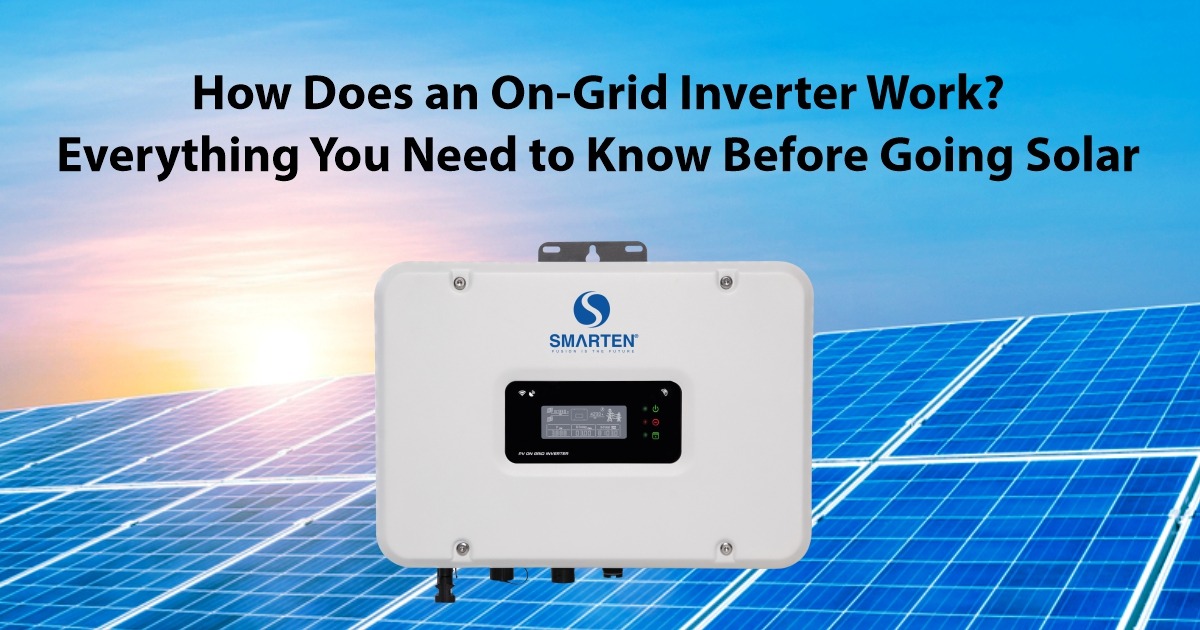
With the rising demand for clean and sustainable energy, solar power is quickly becoming a preferred choice for homes and businesses across India. While solar panels are the face of solar technology, it’s the inverter that is the real brain behind the operation. Especially in grid-tied systems, on-grid inverters play a crucial role in converting and managing solar energy effectively.
But what exactly is an on-grid inverter, and how does it work? In this blog, we’ll explain everything you need to know about on-grid solar inverters, including their function, benefits, working mechanism, and things to consider before installing one.
What is an On-Grid Inverter?
An on-grid inverter (also known as a grid-tied or grid-connected inverter) is a type of solar inverter that is connected to the main utility grid. It converts the DC (Direct Current) electricity generated by solar panels into AC (Alternating Current) electricity, which is used to power household appliances.
The unique feature of on-grid systems is that they don’t use batteries. Instead, they feed excess electricity back to the grid and draw power from it when needed — creating a seamless energy flow between your home and the utility provider.
Key Components of an On-Grid Solar System
Before diving into the working process, let’s understand the main components involved:
How Does an On-Grid Inverter Work?
Here is a step-by-step explanation of how an on-grid inverter operates:
✅ Step 1: Solar Energy Generation
Solar panels absorb sunlight and generate DC electricity. This energy, however, cannot be used directly by most appliances as they run on AC power.
✅ Step 2: Conversion of DC to AC
The on-grid inverter takes the DC output from the solar panels and converts it into AC power compatible with the local utility grid’s voltage and frequency.
✅ Step 3: Powering the Load
The converted AC power is first used to run your household or office appliances. If your solar system generates more power than required, the excess energy is sent to the grid via a net meter.
✅ Step 4: Net Metering
The net meter keeps a record of how much electricity you consume from the grid and how much you supply back. At the end of the billing cycle, the net value is calculated, and you are billed only for the difference — this is called net metering.
✅ Step 5: Grid Dependency
When your solar panels don’t produce enough energy (like at night or during cloudy days), the inverter automatically pulls electricity from the grid to ensure uninterrupted power supply.
Advantages of On-Grid Inverters
🌞 1. Cost-Effective
Without the need for batteries, on-grid systems are more affordable and have lower maintenance costs.
🔄 2. Efficient Energy Use
These inverters ensure that all available solar power is first used by your appliances before pulling from the grid.
📉 3. Reduced Electricity Bills
Thanks to net metering, any excess energy you export to the grid can offset the power you draw later — significantly reducing your monthly bills.
🌍 4. Eco-Friendly
Using solar power reduces dependence on fossil fuels and lowers your carbon footprint.
🧠 5. Smart Monitoring
Most modern on-grid inverters come with apps or web portals to monitor real-time performance and energy usage.
Limitations of On-Grid Inverters
While on-grid inverters are excellent for reducing electricity bills and maximizing solar usage, there are a few limitations to keep in mind:
⚡ 1. No Power Backup
On-grid inverters do not work during power outages. Since they are directly connected to the grid, they shut down to prevent “islanding” (sending power to the grid during a blackout, which can be dangerous for utility workers).
🔋 2. No Battery Storage
If you want to store solar energy for nighttime use or power cuts, you’ll need to consider hybrid or off-grid systems with batteries.
Things to Consider Before Installing an On-Grid Inverter
If you’re planning to switch to solar with an on-grid system, consider the following:
✅ 1. Local Grid Availability
Ensure that your area has a stable grid connection since on-grid inverters depend entirely on it.
✅ 2. Net Metering Policy
Check whether your state’s electricity board supports net metering and what their current policies and rates are.
✅ 3. System Size
Determine how much electricity your household consumes monthly. A professional solar installer can help you size the system accordingly.
✅ 4. Roof Space and Direction
Adequate shadow-free rooftop space is essential for effective solar generation.
✅ 5. Inverter Brand and Warranty
Choose a trusted and certified on-grid inverter brand like Smarten, which offers high efficiency, longer warranty periods, and excellent after-sales support.
Conclusion: Is an On-Grid Inverter Right for You?
An on-grid inverter is an ideal choice for homeowners and businesses that want to reduce their electricity bills and embrace clean, green energy without the additional investment in batteries.
By converting solar energy into usable AC power and integrating smoothly with the main grid, an on-grid inverter offers a smart, reliable, and low-maintenance solution. Just ensure you live in a grid-connected area and are eligible for net metering.